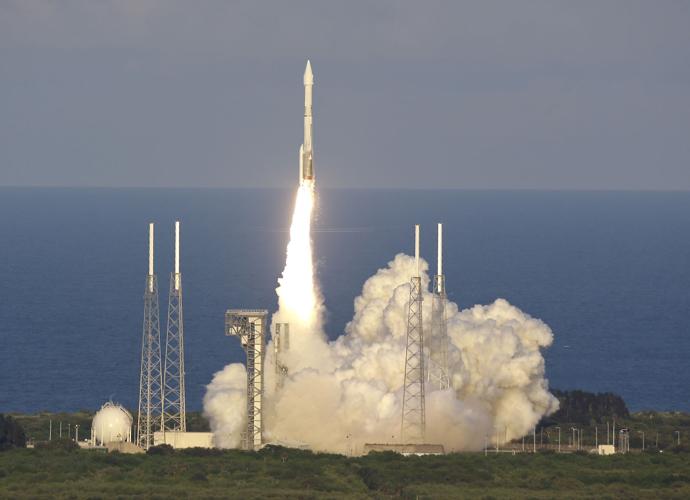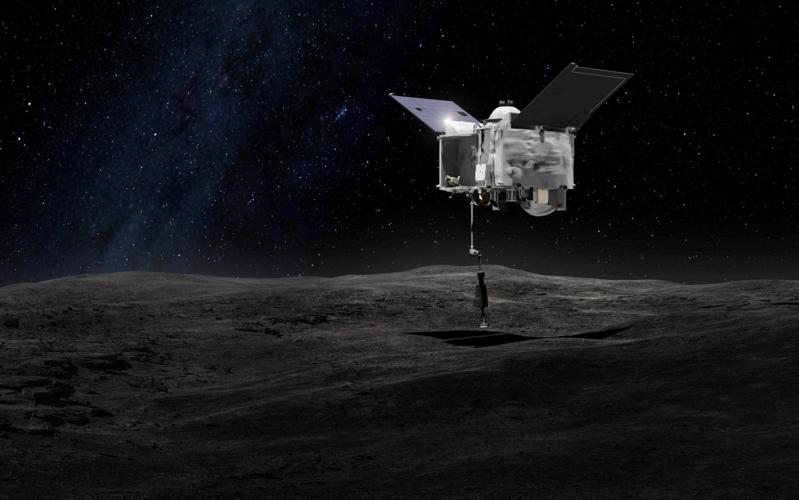OSIRIS-REx is headed for Bennu.
A United Launch Alliance Atlas V rocket bearing the OSIRIS-REx spacecraft and the hopes and plans of a small army of planetary scientists led by the University of Arizona, lifted from Cape Canaveral Thursday on-time and without incident at 4:05 p.m. MST.
About 300 UA students, scientists, administrators and donors were among the estimated 8,000 spectators at Cape Canaveral, Florida, cheering the launch of NASA’s first mission to sample an asteroid.
The spacecraft, whose scientific mission was conceived by scientists at the University of Arizona’s Lunar and Planetary Laboratory, will rendezvous with an asteroid named Bennu after a two-year, 2-billion mile journey.
The spacecraft will catch up to the asteroid and fly in formation alongside it to characterize its composition.
It will use an array of instruments — a thermal spectrometer supplied by Arizona State University’s School of Earth and Space Exploration, a LIDAR altimeter from the Canadian Space Agency, a visual and infrared spectrometer from NASA Goddard, an X-Ray Imaging Spectrometer built by a student team at Harvard and MIT, and a suite of cameras built by the UA’ Lunar and Planetary Lab, which also hosts the mission’s Science Processing and Operations Center.
Scientists will scrutinize the surface of Bennu to select the perfect site to gather up a handful of loose soil and return it to Earth in a sealed container seven years from now.
OSIRIS-REx is the third of NASA’s New Frontiers missions, all led by unaffiliated principal investigators, in this case Dante Lauretta, a UA professor of planetary sciences, who has spent his career studying meteorites for clues to the formation of the solar system and the origin of life on Earth.
This mission is NASA’s first attempt to grab a chunk of solar system history from an asteroid. LPL scientists chose Bennu because it was close-by and had the spectral signature of carbon, the essential element in organic compounds such as amino acids, the building blocks of life.
Return of the sample — at least 2.1 ounces of pristine space dust and as much as 4.4 pounds — will mark the beginning of a scientific investigation that will last decades.
The $1 billion mission was originally proposed as a less ambitious one by the late Michael Drake, former director of the Lunar and Planetary Lab at UA, who initially worked with colleagues at Lockheed Martin Space Systems on the proposal.
It took three tries, but Drake, who brought on Lauretta as deputy principal investigator, finally won an $803 million NASA contract, the largest ever won by the UA, in May 2011. Six months, Drake died.
A plaque honoring him is flying with the spacecraft and the scientific part of the mission will be run from the off-campus building now named the Michael Drake Building.
It once housed the Phoenix Mars Lander team, the first NASA mission led by the UA, and was reconfigured to accommodate up to 400 scientists from across the globe who will be present for critical operations of OSIRIS-REx.
It is not the only campus construction project spawned by the mission.
The sub-basement of the Kuiper Space Sciences building, built with NASA money during the Apollo era, is being retrofitted for vibration-free, atomic-level analysis of samples.
The Kuiper building itself was built in 1965 with money from NASA, which was promoting the new field of planetary science essential to its planned Apollo moon missions. Since then, UA planetary scientists have participated in every NASA robotic mission to a planet or moon.
Timothy Swindle, current director of LPL, was excited at the prospect for those analyses when reached by phone shortly before launch.
“Personally, it’s just fascinating to watch something I’ve seen go from an idea 12 years ago to a launch pad today. At LPL, we’ve done all sorts of great things, but this might be the greatest. It’s a big deal,” he said.






